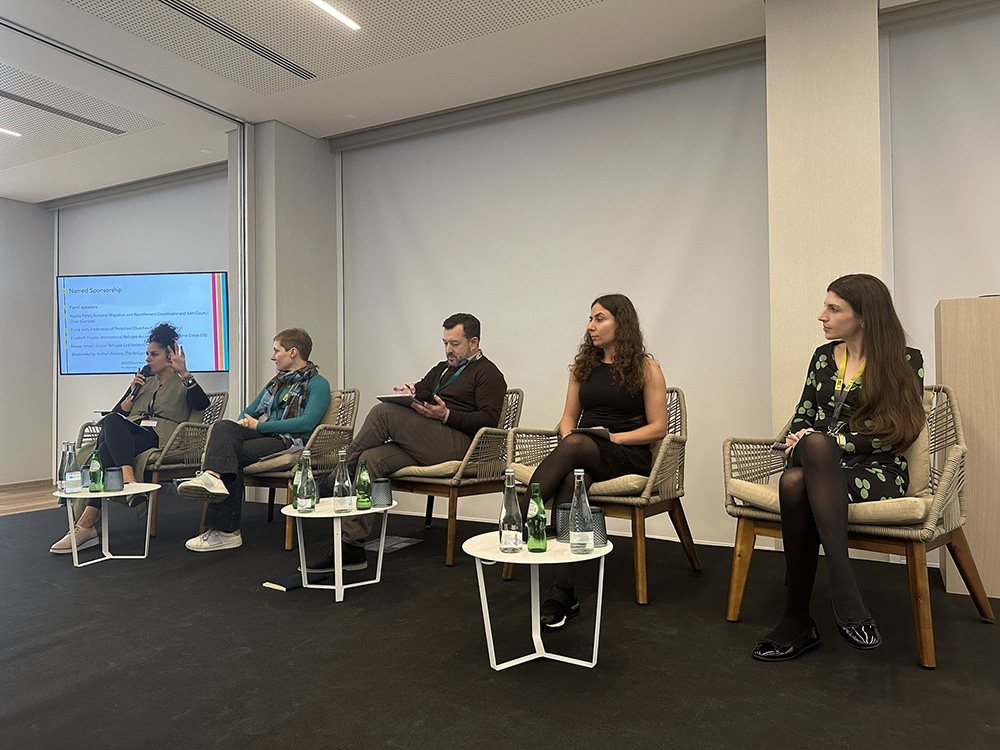 The Global Gathering for Sponsorship, held in Lisbon from 7 to 9 November, brought together 130 experts from 4 continents and 23 different countries. There was a variety of skills, experiences and points of view that help contribute to the growth of the organisations’ network and communities involved in Community Sponsorship. It is a transformative practice, starting from the activation and involvement of local communities, that has the power to change the narrative, policies and practices of refugee reception. The FCEI, as part of the COMET’s network, took part in the event by bringing the consolidated experience of Humanitarian Corridors. They reflected and discussed the various challenges on how to enrich and diversify strategies to maximise the amount of protection available.
The Global Gathering for Sponsorship, held in Lisbon from 7 to 9 November, brought together 130 experts from 4 continents and 23 different countries. There was a variety of skills, experiences and points of view that help contribute to the growth of the organisations’ network and communities involved in Community Sponsorship. It is a transformative practice, starting from the activation and involvement of local communities, that has the power to change the narrative, policies and practices of refugee reception. The FCEI, as part of the COMET’s network, took part in the event by bringing the consolidated experience of Humanitarian Corridors. They reflected and discussed the various challenges on how to enrich and diversify strategies to maximise the amount of protection available.
Plenary concept note: Named Sponsorship
Wednesday, November 8, 2.15 – 3.45
Session outline
Named sponsorship – also referred to as ‘identification’, ‘nomination,’ or a two-sided visa’ – can be a driver of both scale and diversity in sponsorship and is increasingly a feature of sponsorship initiatives in countries across the globe. We have seen named programs develop as part of crisis response efforts, or as features of new permanent programs. In some cases, naming has evolved in the absence of a defined policy framework.
This session will explore developments in this area, discuss the potential of naming and identify some key learnings on the adoption of named sponsorship programs to date.
Giulia Gori, Federation of Protestant Churches in Italy (FCEI), Italy
Italy has one of Europe’s largest sponsorship programs, and naming is a core element of how the program operates. Can you tell us about how naming features in the Italian programme and how it has helped support the growth of sponsorship in Italy, including during moments of crisis?
In the Italian programme of Humanitarian Corridors, there is no mandatory UNHCR identification of participants as potential candidates are generally interviewed and assessed directly by the staff of the implementing organisations. This is quite an exception in comparison with other models developed abroad. Although participants need to be under the broad UNHCR mandate, formal recognition by UNHCR is not required as full territorial asylum procedure is subsequently carried out once in Italy by the national competent Commission.
This has allowed implementing organisations a certain degree of flexibility in developing what it can be considered a named sponsorship, a model allowing sponsors to ‘name’ the persons they would like to sponsor.
Just to give you some exampes, we have been spontaneously approached by a number of people having direct link and personal relationship with Afghan nationals in need of protection and offering to sponsor them. We have been contacted by people having had previous work relationship with someone in need of protection, of being a friend of some family member already in Italy. Similarly, we have been approached by someone having a broader connection with a specific profile (i.e. membership in a particular social group such as LGBTQI+ community, or in a specific professioanl group such as doctors or lawyers ).
In all these cases, the element of affinity clearly represents the trigger for sponsors’ action. In this model, the sponsor is triggered precisely by the willingness to host a specific person or family or case (to which the sponsor is related or feels connected by an element of affinity). If his or her preference is not incorporated, the sponsor would probably back out, resulting in a loss of potential.
Thus, according to our experience, named or nominated sponsorship is key to maximise the potential of sponsorship
We sometimes hear concerns that named programs may not be reaching the most vulnerable / those with the greatest need of resettlement. I would be interested in hearing your perspective on that. Are there ways that named programs can increase access to protection for especially vulnerable groups?
Univocally defining what vulnerability means is extremely challenging. Likewise, how can we measure and compare vulnerabilities? How can we make a hierarchy among people with protection needs? Let’s see what is currently happening in Afghanistan, where every single girl, just because they are women, cannot attend school and cannot enjoy their human right to education. How can we decide who is most vulnerable and deserving under this framework? This is evidently not possible.
I personally believe we should get to grips with the fictional idea of being able to have full control over every aspect of the process. We should simply accept the idea of not being omnipotent.
Thus, if this is so, I also believe we are asking ourselves the wrong question. The key point should not be how to reach the most vulnerable, but rather how to maximise the space for protection so to offer sustainable solutions to the majority of people with vulnerabilities.

